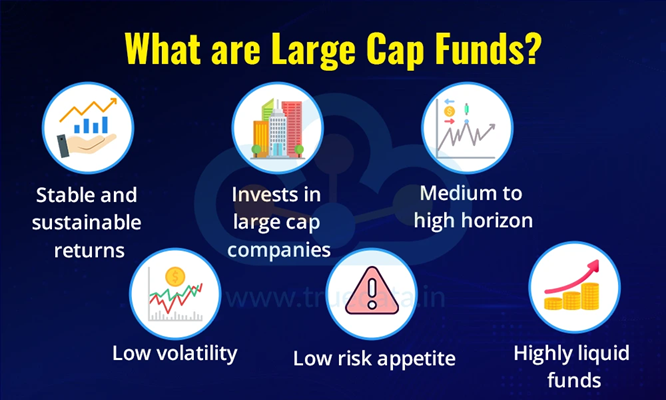The Ideal Combination of Security and Growth
The search for high-yield investments in a less certain manner can be addressed by large-cap mutual funds. These funds are invested in the biggest, closely owned businesses in India that have a proven track record of capital growth and lower investor volatility. The greatest choice for dependable growth with minimal risk is a large-cap mutual fund.
Large Cap Mutual Funds: What Are They?
Large size mutual funds make investments in big businesses, with the majority of the companies they invest in having market capitalizations in the top 100 (often over ₹20,000 crore). These companies are dominant in their respective industries, have huge customer bases, and typically withstand economic downturns. By directing investments to these well-established organizations, these funds prioritize stability while utilizing them to investigate potential for stable growth.
Consistent Growth with Minimal Volatility
Large cap funds thrive on volatility, while small cap funds are subject to sharp ups and downs in response to market sentiment. Over time, smoother performance is ensured by their focus on industry leaders—businesses with strong revenue streams and effective management. Although returns might not reach the stratosphere right away, they will compound over time, making them the preferred option for investors and people aiming to save for retirement or other long-term objectives.
Liquidity: Strategies for Getting Out of Tough Markets
One of the amazing characteristics of large-cap funds is their high liquidity. Investors can quickly redeem units to reduce losses during weak markets, which isn’t always possible with smaller-cap competitors. Fund managers can benefit from market declines by buying low and selling high, which allows them to acquire cheap equities that they can resell and hopefully make money on. The robustness of the portfolio is improved by this adaptability.
Diversification Among Leading Markets
Purchasing a portion of big India—the corporate behemoths in the banking, IT, and consumer goods sectors—is the essence of investing in large-cap mutual funds. By diversifying the business, it reduces its dependence on any one area and shields it from its drawbacks.
Diversification lowers portfolio risk and increases its ability to respond to changes in the economy, but it does not completely remove risk.
Prospects for Long-Term Wealth and Dividends
Large-cap investors benefit from patience. As businesses increase their market share and profitability over the course of five to seven years, these funds frequently yield double-digit returns. Many also provide periodic income by distributing dividends on steady revenues. Despite being taxed, dividends add to total returns, which is why these funds are appealing for passive income and wealth accumulation.
Risks: Controllable with caution
Investing is never risk-free. Large cap funds are influenced by changes in interest rates, market volatility, and sector concentration. However, compared to aggressive equity choices, these risks are lessened for solid organizations. These investors should compare fund performance history, exit loads, and expense ratios to their risk tolerance in order to make the best decisions.
Optimal Investors: Safety-First Approaches
Large-cap mutual funds are appropriate for novice investors, cautious investors, and those constructing a core portfolio. For those who want exposure to equity markets without the wild ride of volatile assets, they are ideal. Compounding returns and tax efficiency for profits longer than a year are other advantages for long-term planners.
Tax Efficiency Increases Profits
Large size fund profits kept for more than a year are considered long-term capital gains (LTCG), which are taxed at a favorable rate of 10% above ₹1 lakh per year, as opposed to 15% for short-term gains. Although they are taxable as income, dividends increase the fund’s attractiveness to people in lower tax bands.
Commencing Your Investment Adventure
Platforms that provide a variety of plans, zero hidden fees, and SIP calculators make investing in high-yield mutual funds easier. Depending on their risk tolerance and financial objectives, investors can select lump-sum or systematic (SIP) investments. In order to make well-informed decisions, research tools assist in comparing sector allocations, expense ratios, and historical performance.
Conclusion:
A Basis for Monetary Objectives
Ambition and prudence are balanced by large-cap mutual funds. They provide a lucrative and comforting route to riches by fusing the power of market leaders with long-term, disciplined investing. These funds provide a calculated introduction into the equity markets for investors who are prepared to put stability above growth.


